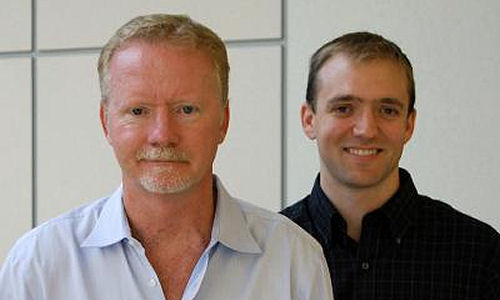Scientists at The Scripps Research Institute (TSRI) have found a way to apply a powerful new DNA-editing technology more broadly than ever before. “This is one of the hottest tools in biology, and we’ve now found a way to target it to any DNA sequence,” said Carlos F. Barbas III, the Janet and Keith Kellogg II Chair in Molecular Biology and Professor in the Department of Chemistry at TSRI.
The breakthrough concerns a set of designer DNA-binding proteins called TALEs, which biologists increasingly use to turn on, turn off, delete, insert or even rewrite specific genes within cells—for scientific experiments and also for potential biotech and medical applications, including treatments for genetic diseases.
TALE-based methods had been considered useful against only a fraction of the possible DNA sequences found in animals and plants, but the new finding removes that limitation.
Barbas and his team report their finding on August 26, 2013 in an advance online edition of the journal Nucleic Acids Research.
Useful Tools
Molecular biologists have long dreamed of being able to manipulate DNA in living cells with ease and precision, and by now that dream is nearly a reality. TALE-based designer proteins, introduced just a few years ago, are arguably the most user-friendly and precise DNA-directed tools that have yet been invented.
Designer TALEs (transcription-activator-like effectors) are based on natural TALE proteins that are produced by some plant-infecting bacteria. These natural TALEs help bacteria subvert their plant hosts by binding to specific sites on plant DNA and boosting the activity of certain genes—thereby enhancing the growth and survival of the invading bacteria.
Scientists have found that they can easily engineer the DNA-grabbing segment of TALE proteins to bind precisely to a DNA sequence of interest. Typically they join that DNA-binding segment to another protein segment that can perform some desired function at the site of interest—for example, an enzyme fragment that cuts through DNA. Collectively the Barbas laboratory and others in this field have already engineered thousands of these powerful TALE-based DNA-editing proteins.
However, TALE-based DNA-editing has been seen to have a significant limitation. Virtually all the natural TALE proteins that have been discovered so far target sequences of DNA whose transcription begins with the nucleoside thymidine—the letter “T” in the four-letter DNA code. Structural studies have hinted that natural TALE proteins can’t bind well to DNA without that initial T. Molecular biologists thus have widely assumed that the same “T restriction” rule applies to any artificial TALE protein they might engineer.
“Yet no one has investigated thoroughly whether that initial thymidine is truly required for the variety of TALE designer proteins and enzymes that now exist,” said Brian M. Lamb, a research associate in the Barbas Laboratory who was first author of the new study.
Questioning Assumptions
Lamb started by evaluating how well TALE-based proteins function against their usual DNA targets when the first DNA letter is switched from a T to one of the other three nucleosides (A, G or C). Using a library of natural and engineered TALE proteins, he found strong evidence in favor of the “T restriction” rule. “There was an orders-of-magnitude difference—some of the TALE proteins we evaluated lost as much as 99.9% of their activity when we changed that first nucleoside base,” said Lamb.
But he wasn’t ready to give up on the possibility of designing more broadly useful TALE proteins. For this he adapted a “directed evolution” technique developed last year by Andrew C. Mercer, who at the time was a research associate in the Barbas laboratory. First, Lamb generated a large library of novel TALE proteins that vary randomly in the structures they hypothesized to grab the initial nucleoside. He then put these new TALEs through a series of tests, to select—in a speeded up version of natural evolution—those that work adequately even with a non-T nucleoside at the start of their target DNA sequence.
In this way, he found several new TALE protein architectures that aren’t held back by the T restriction. One prefers to bind to DNA that begins not with a T nucleoside but with a G (guanosine). Others bind well enough to sequences that start with any of the four DNA nucleosides. Lamb found that these non-T-restricted TALEs work as designed when conjoined, for example, to DNA-cutting enzyme fragments. “Essentially we abolished the T requirement,” said Lamb.
“That means that the number of DNA sites we can target with TALE-based proteins, and the precision with which we can target within any given gene, have gone up dramatically,” Barbas said.
A Multitude of Potential Uses
He and his team plan to follow up the discovery mostly by using the new unrestricted TALE-based proteins as tools for developing potential gene therapies. But the removal of the “T restriction” on TALE-based DNA editing should have a positive impact also on basic molecular biology, biotechnology, stem cell medicine, and nanotechnology when they are combined for example with DNA origami. Indeed any application that requires the manipulation of DNA in living cells or even the construction of protein-DNA machines should benefit from this breakthrough.
“The number of potential uses of this technology is probably more than any one person can imagine,” Barbas said.
The study, “Directed Evolution of the TALE N-Terminal Domain for Recognition of All 5’ Bases,” was funded in part by the National Institutes for Health Pioneer Award (grant DP1CA174426). For see the study, see http://nar.oxfordjournals.org/content/early/2013/08/26/nar.gkt754.full-text-lowres.pdf





